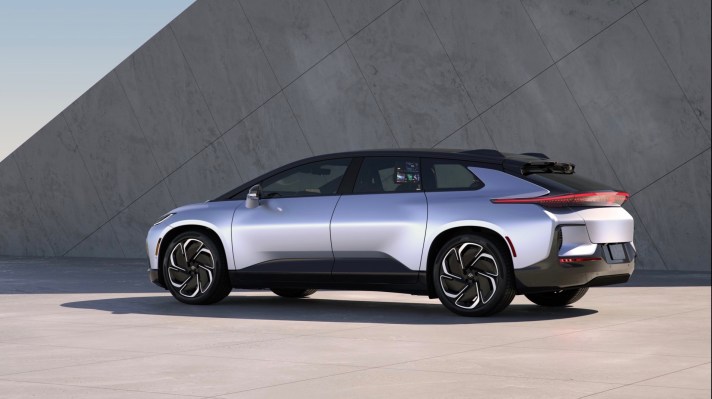
Faraday Future said Wednesday it plans to start production of its all-electric FF 91 Futurist SUV at the end of March after years of delay, lack of capital and internal drama that threatened the company’s existence.
Faraday Future had previously indicated that production would start in March, but had yet to select a date.
There are two caveats to this milestone, however. The company said in its full-year and fourth-quarter earnings report that start of production will begin March 30 if it receives the remaining funds expected from investors and if suppliers are able to meet its requirements. Faraday Future said in February that it had reached financial commitments of $135 million in convertible secured notes, capital that the company said would allow it to start production. About $111.6 million of funds have been received. The company is expecting to more incremental payments of $38.4 and $58.4 million.
CEO Xuefeng Chen said Wednesday during the company’s earnings that he was confident the funds would be received.
The FF 91 will be assembled at its Hanford, California facility. The first vehicles are set to come off the assembly line in early April with customer deliveries occurring before the end of that month, the company said. Chen said the company is initially targeting sales in the Los Angeles area followed San Francisco Bay Area, and the New York metro region. In China, the company’s initial sales efforts will begin with Shanghai and Beijing, he said.
Faraday Future shares fell 8% to $0.51 a share prior to the earnings report being released. The production update helped push shares up in after-hours trading about 0.44% despite a rather dismal earnings report.
Faraday Future didn’t generate any revenue in the fourth quarter or 2022 for that matter. Its operating expenses were $451 million in 2022 compared to $354.1 million in the previous year. Faraday said the bulk of operating expenses were in the first nine months of the year due to an uptick in engineering, design and testing costs.
The company reported a net loss of $552.1 million for 2022, about 7% higher than the $516.5 million it lost in the prior-year period. The net loss in the fourth quarter was $153.9 million compared to $84.3 million in the same year-ago period.
Faraday Future reported it ended the fourth quarter with $18.5 million in cash and restricted cash. The company’s cash position has improved and is now $37.5 million, including restricted cash of $2.1 million as of March 3, 2023.
While there are conditions to that start-of-production date it still marks a turnaround for a company that just four months ago had substantial doubt as to whether it would be able to continue operating over the next year.
At the time, Faraday cited a number of conditions that were delaying deliveries of its FF 91, including whether suppliers could meet their deliverables, the timing and success of certification testing and the implementation and effectiveness of the company’s headcount reductions. Top of the list of concerns was whether Faraday would be able to secure the funds it needed to make it through the year, much less make it to first deliveries.
The company board ousted CEO Carsten Breitfeld a week later and appointed Xuefeng Chen, a former and longtime Chery Jaguar Land Rover executive who most recently led Faraday Future’s China division, as its new leader.
Faraday Future has grappled with delays and drama for years, which escalated after going public in July 2021 via a merger with special purpose acquisitions company Property Solutions Acquisition Corp. In July 2022, the company pushed its start of production and first deliveries to the third and fourth quarter, citing supply chain issues and a lack of money.
